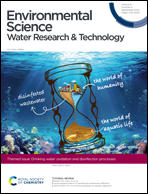Total organic halogen (TOX) species formation at different locations in drinking water distribution systems†
Abstract
Total organic chlorine (TOCl), bromine (TOBr) and iodine (TOI) species and collectively total organic halide (TOX) concentrations were quantified quarterly at 11 US drinking water treatment plants (WTPs) and distribution systems. TOCl was the dominant halogen-specific TOX species in most plants. TOBr concentrations varied with source water bromide (Br−) concentrations at WTPs. TOI was always below the minimum reporting level even though iodine species were present at >1 μg L−1 in some source waters. Ratios of TOCl to TOBr varied seasonally. TOCl increased as intake DOC increased in some plants. Seasonal changes in raw water Br− concentration did not lead to the corresponding variations in TOBr concentrations for most WTPs. For WTPs practicing chloramination, TOCl and TOBr concentrations did not increase significantly from the effluent into their distribution systems. Chlorine contact time for both pre-oxidation and post-chlorination prior to ammonia addition was the most important factor affecting the TOX formation in WTPs. On the other hand in distribution systems with free chlorine residuals, TOCl and TOBr concentrations increased as long as residual chlorine was available. Despite seasonal variations, the ratios of regulated brominated disinfection by-products to TOBr (i.e., Br-DBP/TOBr) were lowest for chloraminated plants treating groundwater and generally higher for WTPs utilizing free chlorine. We observed TOBr levels as high as 116 μg L−1 in one distribution system, while the ratio of regulated brominated DBPs to TOBr was as low as 15% in some systems indicating that the major portion of TOBr in the finished water is unidentified and unmeasured. Given the higher toxicity of brominated DBPs than their chlorinated analogs, it is important to develop treatment and/or operational strategies to reduce the formation of TOBr in distribution systems in order to minimize exposure of the public to such DBPs.

- This article is part of the themed collection: Drinking water oxidation and disinfection processes


 Please wait while we load your content...
Please wait while we load your content...